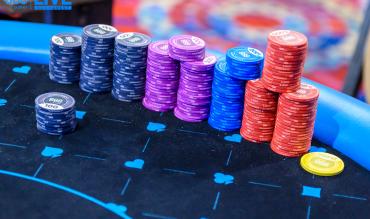The ultimate dream of aspiring players learning how to play poker, and even current professional poker players, is to raise the stakes.
Everyone wants to know what high stakes poker means and how to break into the scene.
Define High Stakes: What Does High Stakes Mean
In terms of developing your game plan, you should identify what you consider to be high stakes.
- $2/$5: The $2/$5 blind level (or similar) is available in most local casinos. While not exactly high-stakes poker games like people imagine on television, it is the first level where you will reliably find stake poker players and professionals alike. Some venues allow you to buy in for as much as $1,000 or more at this level. Still, it's primarily recreational players or an even split of recs vs pros.
- $5/$10: You will usually find more pros than recreational gamblers at this level. The $5/$10 blind level is low enough to run regularly in most casinos. However, they will typically run only during big poker tournament series or on weekends unless you’re in a major city. For many people, reaching the $5/$10 level means they’ve achieved their goals of playing at higher stakes and being considered high stakes poker players.

- Stream games/Private games/Macau: The indisputable ‘high stakes’ barrier starts at $10/$20 —- and goes far above. Livestream games on YouTube will regularly feature $50/$100 and even $100/$200. Invite-only games — including at casinos —- can require $50,000 minimum buy-ins. And if you visit Macau, you can play for millions.
High-Stakes Poker Tournament Strategy: Tips for Higher Stakes Players
What is high stakes? In tournaments, high-stakes events can range from $1K buy-ins to $10,000 and more in WPT poker tournaments and even the Main Event at the World Series of Poker.
Here’s a bit of advice on tournament bankrolls:
- You need a larger bankroll to play tournaments due to the increased variance. While you can get by on 30 buy-ins for a cash game, you can easily need 100 buy-ins for a tournament.
- So, to play $1,000 cash games, you’d ideally want a $30,000 bankroll. But to protect yourself in tournaments, you’d need a $100,000 bankroll to play $1k buy-ins.
- Most people do not have those kinds of funds. Instead, it is incredibly common to get ‘staked’ for tournaments and have investors front a large percentage of your buy-in.
- You can also win your seat via satellites and contests.
By this logic, even $100 tournaments are high stakes, as you would need a $10,000 bankroll to handle the variance and risk effectively.

However, the principles of bankroll management can safeguard your poker funds, ensuring you don't go broke. If you have additional sources of income outside of poker, you can afford to be more aggressive with your bankroll.
You can take shots at bigger games without the same risk of financial ruin.
Rising to Higher Stakes: How to Play High-Stakes Poker Like a Pro
$2/$5 High Stakes Meaning and Strategy for Beginners
Walk before you run! Don’t start playing massive $10k stream games until you can reliably beat a daily $2/$5. The easiest way to do so is by playing better hands than your opponents.
Master preflop position and poker hand rankings charts —- know which cards to play when —- and you’ll already be well on your way.
Most people get attached to their cards and play way too many hands. Exercise discipline, and you will cruise through the lower to mid-stakes. Also, learn the different statistical probabilities, like the likelihood of flopping a set or completing a flush.

Get a firm grasp on the maths and the different positions. Develop the discipline to stick to your strategy, especially when bad luck and tilt inevitably become factors in the game.
$5/$10 High-Stakes Poker Strategy: Mastering Mid-Level Games
This level can make or break pros. You can beat a $2/$5 without getting too fancy, but advancing further requires a few tricks up your sleeve.
You need to know how to outplay your opponents —- and avoid getting outplayed.
The key to both? Position.
You must understand how to utilise your position at the table to your advantage:
- Practise re-raising 3-betting) when in position to isolate your opponents.
- Do not call 3-bets light when you are out of position.
When you are in position, you are at a considerable advantage. Seeing how your opponents react allows you to make better decisions than them and reduce mistakes.
You also can generate larger pots.

By having the last action, you usually get to dictate the bet sizes.
Since you cannot win every hand in poker, the hands you do win must be at a high enough margin to overcome your losses. Therefore, bloating the pot when in position can work to your advantage.
- Let’s say you 3-bet a hand like Jack-Ten, for example. If the poker board favours your opponent, you can avoid putting in chips unnecessarily in position.
- But when you smash the flop (or turn! or river!), you can win much more since you swelled the pot when in position. It’s a very powerful tool that pros wield wisely.
To succeed at these stakes, you need to be able to manipulate the game in your favour. You also need the insight to run when an opponent is trying to use the same exploits.
High-Stakes Poker Games: Stream Games, Private Games, and Macau
Focus on acting carefully and meticulously as you sharpen your poker combo skill set. You will likely have to do the opposite to score invites to the ‘big games’.
The truth is that the people in these line-ups are highly averse to pros. They don’t want to play against someone disciplined and studied.
These high stakes poker games rely heavily on connections.
Sure, if you’re a big personality with a YouTube channel, you are likely to be able to land a seat on a stream game. Getting an invite back might be a more significant challenge unless you’re a main character with a huge personality.

If you're a savvy player who wants to be invited back to the game, you must balance 'giving action' with' playing winning poker. '
Most juicy games with loose, high-action players splashing chips around only want to play with people ready to gamble. The conservative strategy that led you up to this level will be frowned upon.
Most of these games have only one rule: no nits allowed.
The hard truth is that poker can be political, with your poker cheat sheet banned.
Even high-stakes hot spots like Macau have unwritten rules, frequently changing the game structures to accommodate the big gamblers.
The key is not blowing your bankroll just to get an invite back.
What Is High Stakes Poker? A Guide to Mastering High-Stakes Games
As you advance on your poker journey, your definition of 'high stakes' will likely change. The drama of harnessing a stack of $1,000 can become a mere c-bet. It's a progression —- and, hopefully, a profitable one.
Most beginners will benefit from tightening their game to win by the power of their cards. Later, they surpass this strategy with the power of their plays and, eventually, the power of their personality.
Find a stake where you feel comfortable and can play well.
Remember that high-stakes meaning can vary and may include setting your own limits.


